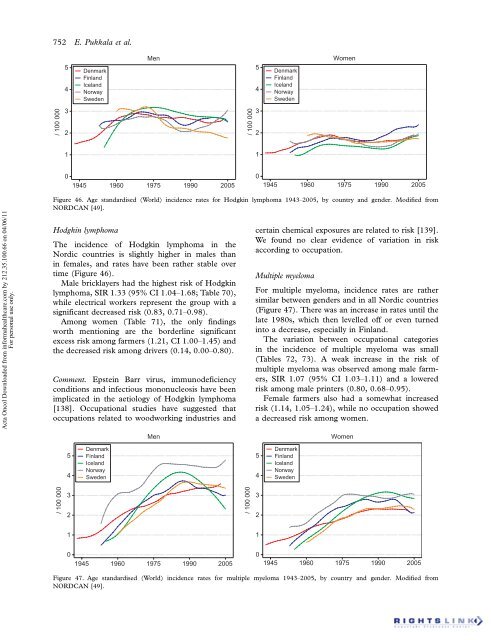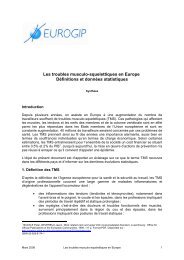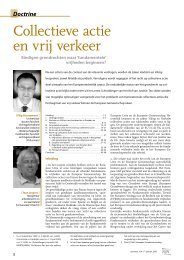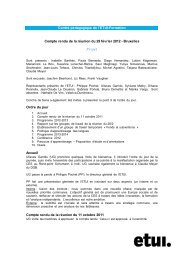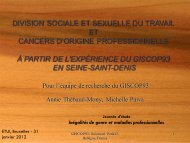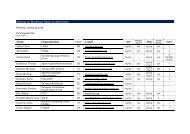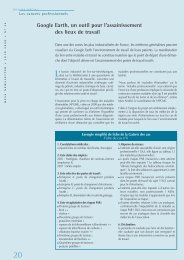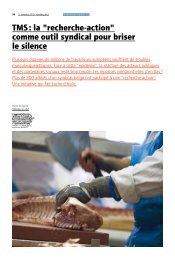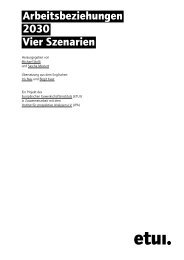Occupation and cancer - European Trade Union Institute (ETUI)
Occupation and cancer - European Trade Union Institute (ETUI)
Occupation and cancer - European Trade Union Institute (ETUI)
Create successful ePaper yourself
Turn your PDF publications into a flip-book with our unique Google optimized e-Paper software.
Acta Oncol Downloaded from informahealthcare.com by 212.35.100.66 on 04/06/11<br />
For personal use only.<br />
752 E. Pukkala et al.<br />
/ 100 000<br />
5<br />
4<br />
3<br />
2<br />
1<br />
0<br />
Denmark<br />
Finl<strong>and</strong><br />
Icel<strong>and</strong><br />
Norway<br />
Sweden<br />
Men<br />
1945 1960 1975 1990 2005<br />
Hodgkin lymphoma<br />
The incidence of Hodgkin lymphoma in the<br />
Nordic countries is slightly higher in males than<br />
in females, <strong>and</strong> rates have been rather stable over<br />
time (Figure 46).<br />
Male bricklayers had the highest risk of Hodgkin<br />
lymphoma, SIR 1.33 (95% CI 1.04 1.68; Table 70),<br />
while electrical workers represent the group with a<br />
significant decreased risk (0.83, 0.71 0.98).<br />
Among women (Table 71), the only findings<br />
worth mentioning are the borderline significant<br />
excess risk among farmers (1.21, CI 1.00 1.45) <strong>and</strong><br />
the decreased risk among drivers (0.14, 0.00 0.80).<br />
Comment. Epstein Barr virus, immunodeficiency<br />
conditions <strong>and</strong> infectious mononucleosis have been<br />
implicated in the aetiology of Hodgkin lymphoma<br />
[138]. <strong>Occupation</strong>al studies have suggested that<br />
occupations related to woodworking industries <strong>and</strong><br />
/ 100 000<br />
5<br />
4<br />
3<br />
2<br />
1<br />
0<br />
Denmark<br />
Finl<strong>and</strong><br />
Icel<strong>and</strong><br />
Norway<br />
Sweden<br />
Women<br />
1945 1960 1975 1990 2005<br />
Figure 46. Age st<strong>and</strong>ardised (World) incidence rates for Hodgkin lymphoma 1943 2005, by country <strong>and</strong> gender. Modified from<br />
NORDCAN [49].<br />
/ 100 000<br />
5<br />
4<br />
3<br />
2<br />
1<br />
0<br />
Denmark<br />
Finl<strong>and</strong><br />
Icel<strong>and</strong><br />
Norway<br />
Sweden<br />
Men<br />
1945 1960 1975 1990 2005<br />
/ 100 000<br />
certain chemical exposures are related to risk [139].<br />
We found no clear evidence of variation in risk<br />
according to occupation.<br />
Multiple myeloma<br />
For multiple myeloma, incidence rates are rather<br />
similar between genders <strong>and</strong> in all Nordic countries<br />
(Figure 47). There was an increase in rates until the<br />
late 1980s, which then levelled off or even turned<br />
into a decrease, especially in Finl<strong>and</strong>.<br />
The variation between occupational categories<br />
in the incidence of multiple myeloma was small<br />
(Tables 72, 73). A weak increase in the risk of<br />
multiple myeloma was observed among male farmers,<br />
SIR 1.07 (95% CI 1.03 1.11) <strong>and</strong> a lowered<br />
risk among male printers (0.80, 0.68 0.95).<br />
Female farmers also had a somewhat increased<br />
risk (1.14, 1.05 1.24), while no occupation showed<br />
a decreased risk among women.<br />
5<br />
4<br />
3<br />
2<br />
1<br />
0<br />
Denmark<br />
Finl<strong>and</strong><br />
Icel<strong>and</strong><br />
Norway<br />
Sweden<br />
Women<br />
1945 1960 1975 1990 2005<br />
Figure 47. Age st<strong>and</strong>ardised (World) incidence rates for multiple myeloma 1943 2005, by country <strong>and</strong> gender. Modified from<br />
NORDCAN [49].


